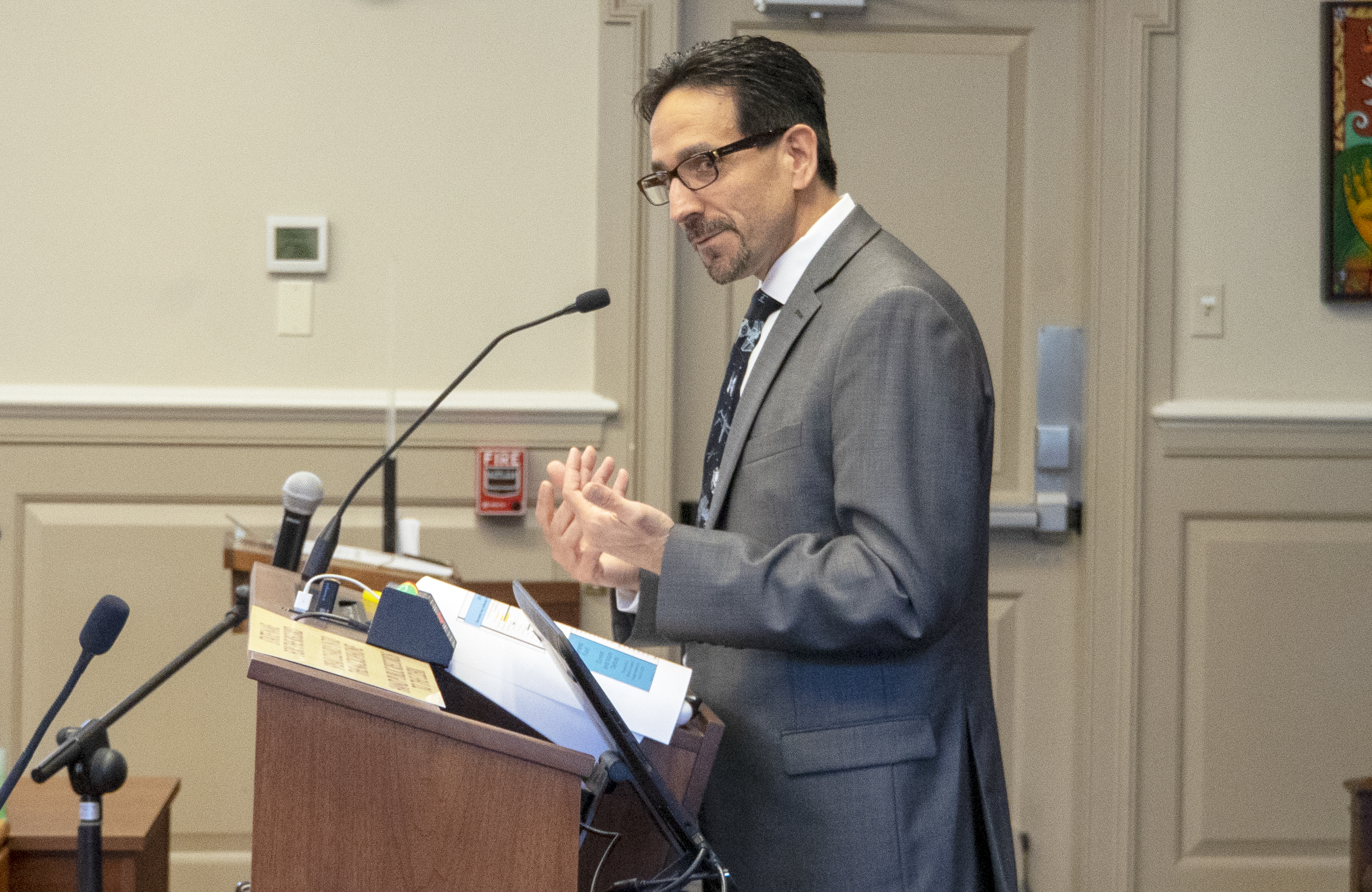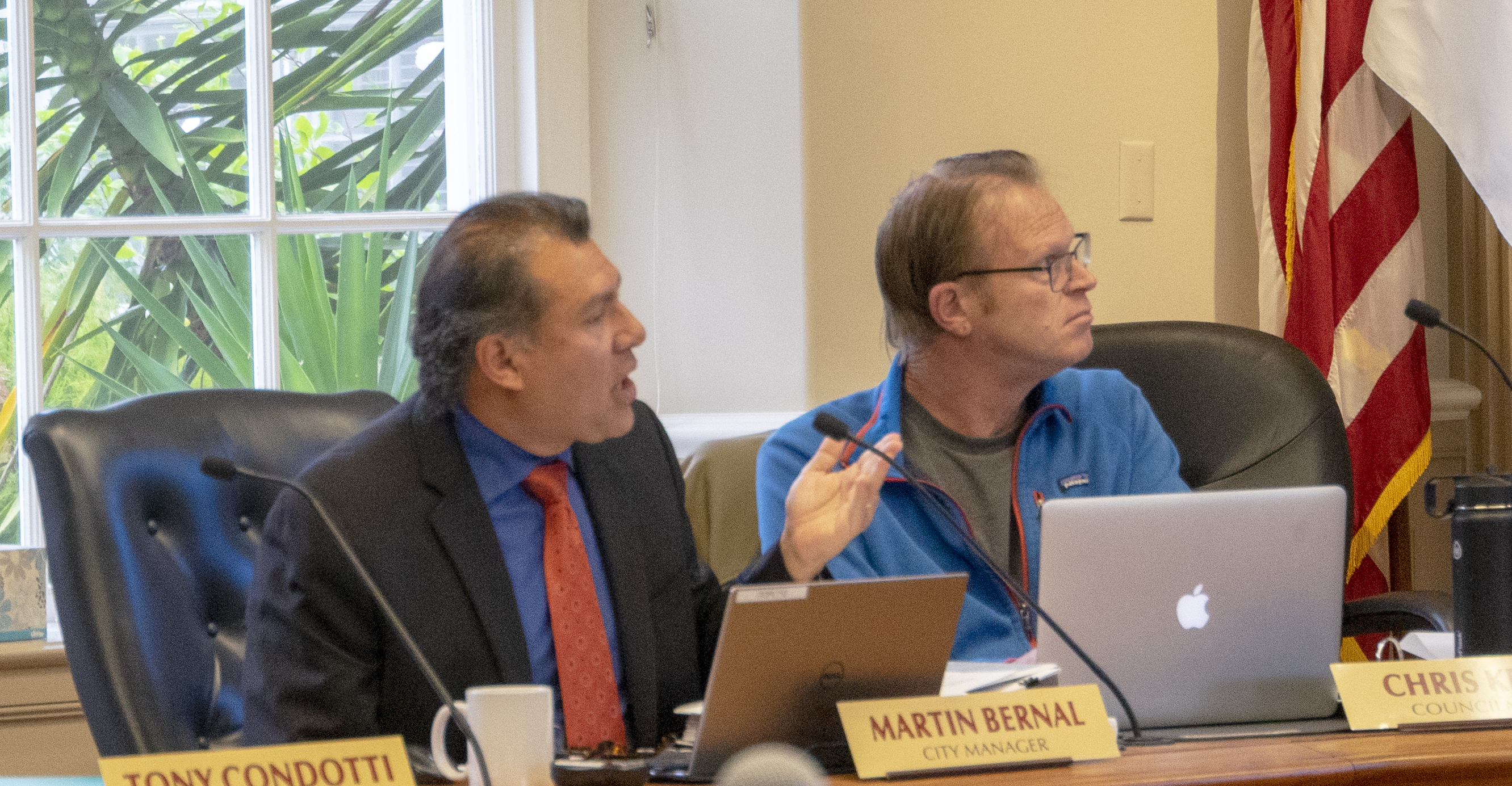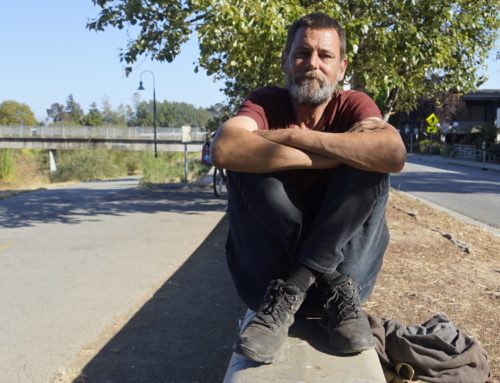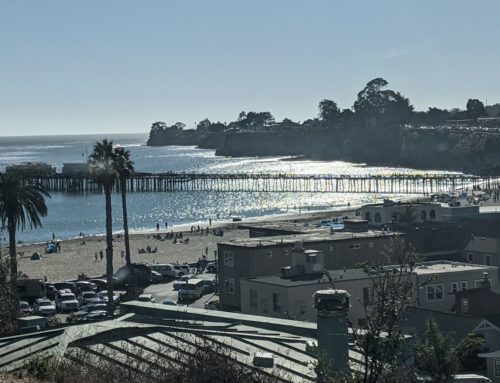The City of Santa Cruz has a $3.2 million deficit. That’s smaller than in years past, but it’s still not good news.
What that means for you is that in the short term, you’re going to be seeing some cuts to city services. You won’t be seeing any large improvement projects for things like parks, the Civic Auditorium, and the wharf. And come election time next year, you’re probably going to be voting on some kind of tax increase.
We’ll discuss what cuts the city is considering, and how we got here.

TRANSCRIPT
Kara Meyberg Guzman: I’m Kara Meyberg Guzman. And this is Santa Cruz Local.
The City of Santa Cruz has a $3.2 million deficit. That’s smaller than in years past, but it’s still not good news.
What that means for you is that in the short term, you’re going to be seeing some cuts to city services. You won’t be seeing any large improvement projects for things like parks, the Civic Auditorium, and the wharf. And come election time next year, you’re probably going to be voting on some kind of tax increase.
[MUSIC FADE OUT]
The Santa Cruz City Council on Wednesday began discussing ways it can cut spending to balance the budget. A plan will take shape over the next few meetings, on May 28 and June 11, and possibly another date, so you’ll have a chance to weigh in. The council’s deadline to approve a budget for the next fiscal year is the end of June.
We’ll discuss what cuts the city is considering. But first, let’s talk about how we got here.
The first thing I should explain is what the city’s general fund is. It’s the part of the city’s budget that’s funded by your tax dollars, like your sales taxes, your property taxes, your utility taxes and the hotels’ taxes. The general fund pays for city departments like police, fire, parks and rec and public works. The general fund is different from what are called enterprise funds, like water, wastewater and refuse, which are self-sustaining through fees. The general fund is much harder to manage because it’s more sensitive to market factors and if the city wants to increase revenue it has to ask the voters.
So, let’s put the city’s general fund deficit in perspective. It used to be much bigger. In 2010, it was a $10 million deficit out of a $60 million general fund. Now it’s $3.2 million out of a $100 million general fund. In the big picture, the city has clawed its way back from the recession, but it’s still not in a place where it can fund ambitious capital improvement projects from the general fund. The tax base is eroding, and so are the city’s reserves.
The deficit is growing faster than expected. The $3.2 million deficit is twice as big as forecasted a few months ago. There are three reasons for that.
Here’s City of Santa Cruz Finance Director Marcus Pimentel at the city council meeting Wednesday. That’s Councilmember Donna Meyers you’ll hear in a bit, laughing in disbelief.

MARCUS PIMENTEL: Going back to 2004, I just looked last night, it was $6 million. So we had a $6 million liability in our miscellaneous benefits to the system. We were nearly 92 percent funded. That feels like a lot back then. I probably remember seeing numbers like that, going like wow, $6 million, holy cow. It’s $100 million now. $107 million. 17,000 percent it’s grown since 2004. And there’s been no benefit change.
DONNA MEYERS: Is that a percent? 17,000 percent? [Laughing]
PIMENTEL: That’s what the math says.
MEYERS: I’ve never heard that before.
PIMENTEL: It’s beyond belief.
[Editor’s note: It’s actually a 1,700 percent increase, but you get the point.]
KMG: After losing big during the recession, CalPERS got conservative with its investments. Too conservative, says Pimentel. Instead of capitalizing on a booming stock market, CalPERS stayed on the sidelines and hasn’t gained much ground. Santa Cruz, and cities across the state, are paying the price.
For example: For the next budget year, which starts July 1, the city owes roughly $11 million to CalPERS. More than $6 million of that cost is just to cover the state’s shortfall, not for employee benefits. That number is forecasted to almost double by 2022.
OK. Here’s the second reason the city has a deficit: unexpected salary increases. This is something the city actually does have some control over.
In March, the city approved a 10 percent raise over three years for its SEIU workers.
SEIU represents 450 employees, half the city’s employees. They do a wide range of jobs, like flood control, parking enforcement, street maintenance and admin work.
That 10 percent raise significantly higher than what the union got in previous negotiations. And it’s higher than what the city expected to pay.

Here’s City Manager Martin Bernal. I spoke to him in his office last week.
MARTIN BERNAL: I don’t mean to say that employees do not deserve their raises, because they do, and more. It’s just a balance of trying to meet those needs with the realities of our budget. And so, in the end, you know, it’s turning out to be higher than we had anticipated. And we’re just going to have to deal with that.
KMG: The raise puts the city in a tougher position as it enters negotiations with the six other bargaining units over the next few months. The SEIU contract will probably be a measuring stick for those labor groups.
The city is already in a tough position. Across many departments, it faces serious recruitment and retention problems, partly due to lower wages.
A November study showed that Santa Cruz city workers have salaries and benefits that are on average 15 percent below those from similar nearby and Bay Area cities.
I spoke with Neal Christen, a water conservation representative at the city who was on the SEIU’s bargaining team. He says morale has been low. He’s a father of two young kids and to make ends meet, he bartends at Little Tampico in Soquel. He commutes from Corralitos, where housing is cheaper.
NEAL CHRISTEN: There’s 10 steps in our pay scale. I’m now topped out. And I still need to work a second job to make ends meet. And so that really bookends the fact that you’re not only talking about brand new employees that are the bottom step fo the pay scale, which for some positions, could be $15 or $16 an hour. I’m at the top, and I still have to work that second job.
KMG: The most beleaguered department in the city is the police, says Lisa Murphy, the city’s HR director. She says the police department has the worst turnover rate she’s seen in her four years at the city.
For the past year, the police department has been down about 30 officers, out of a total of 100 positions. Most of those are officers sidelined by injury, but 11 positions are unfilled, according to Deputy Chief Dan Flippo. Add to that total, 10 officers who are in police academy for six months, meaning that they’re not in the field.
Next week, four police officers are going to retire. By next year, a quarter of the department will be eligible to retire.
So, all that to say, employee raises are a balancing act. The city has to keep one eye on the growing deficit, and another on its serious recruitment and retention problem.
OK. Here’s one more reason the city’s deficit has doubled since the fall: other unexpected costs, several stemming from city council decisions. There are costs to the initiatives that the city council has created, like the rental housing task force and the homeless advisory committee.
There’s also many costs associated with the Ross Camp. City officials say they don’t have an official price tag for the Ross Camp and its cleanup yet.
[MUSIC BREAK]
On Wednesday, the city council began talking about how it could reduce the deficit, mostly through cuts. More work needs to be done and no official decisions have been made.
Here are some of the tentative plans.
- Reducing First Alarm patrols on Ocean Street, in Harvey West, along the San Lorenzo River and at the wharf.
- Billing insurance companies for paramedic services administered by the fire department.
- Raising residential parking permit rates by about $5
- Raising parking meter rates near the beaches
- Reducing brush removal along the San Lorenzo River
- Cutting the frequency of graffiti removal
- Reducing funding for public art
- Delaying maintenance for the wharf
- Cutting funding for Harvey West ball park fencing
- Reducing rental inspections to complaint-based only
- Reducing irrigation at the DelaVeaga Golf Course, and aggressively pursuing a plan to eventually eliminate city subsidy of the golf course
- Reducing funding for community programs and nonprofits
- And reducing funding for the HOPES program, meant to address recidivism for low-level criminals
In addition, the city council approved the formation of a revenue subcommittee, which will look at possible ballot measures for voters in 2020. There are a number of possibilities, including increasing the hotel tax or the parcel tax, a business license tax and a vacant parcel tax.
We’ll get a better picture of where the city is headed by the council’s May 28 meeting. If you have any ideas on what the city should do, be sure to email the city council at [email protected].
You can also send us a 20-second audio letter to the editor. Press record on that voice recorder app on your phone, and email us the file to [email protected].
Just one more thing I’ll add. A few dozen residents urged the council during public comment to address climate change through its budget decisions. The council pressured the city staff to look at transitioning from gas-guzzling to electric cars, and to reduce or delay purchasing of cars in general.
Several other residents spoke with concerns about funding for the library-garage project, but no decisions are expected to be made on that project during the budget meetings.
[MUSIC FADE IN]
That’s it for this episode. If you’re joining us for the first time, Santa Cruz Local is a news organization co-founded by Stephen Baxter and me, Kara Meyberg Guzman. We cover local government and issues like housing, homelessness, land use, crime and planning. You can visit our website, santacruzlocal DOT org, to learn more about our new company, hear more stories, to sign up for our newsletter, and find our transcripts. Again, that’s santacruzlocal DOT org.
I’m Kara Meyberg Guzman. And thanks for listening to Santa Cruz Local. Thanks to Podington Bear, at Sound of picture DOT com, for the music.
[MUSIC FADE OUT]
Kara Meyberg Guzman is the CEO and co-founder of Santa Cruz Local. Prior to Santa Cruz Local, she served as the Santa Cruz Sentinel’s managing editor. She has a biology degree from Stanford University and lives in Santa Cruz.





